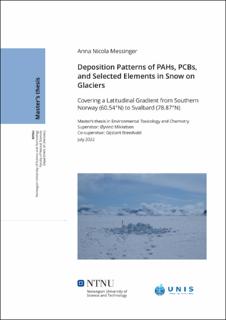| dc.description.abstract | Svalbard is a remote Arctic Archipelago, often considered to have a pristine environment. However, volatile and persistent compounds have been suggested to be transported from lower latitudes to the Arctic via long-range atmospheric transport (LRAT), whereby the distance a compound can travel is correlated to its temperature-dependent volatility, resulting in global (latitudinal) fractionation. Additionally, seasonal temperature changes may lead to the reemission of compounds into the atmosphere, referred to as the grasshopper effect. This study aimed to investigate the deposition patterns of contaminants in snow on remote glaciers along a latitudinal gradient ranging from southern Norway (60.54°N) to Svalbard (78.87°N). In Svalbard, also seasonal changes were investigated. Altogether, surface snow samples from 16 glaciers were collected: 12 glaciers in spring, 3 in summer, and 1 in both seasons. The snow was analyzed for 62 elements using ICP-MS and for the 16 U.S. EPA priority PAHs and 7 PCBs using GC-MS. To identify potential source regions, air pathways to the glaciers were studied using the HYSPLIT model by NOAA, and for emission source identification PCAs were plotted. The study showed that major and trace element concentrations increased by 5.3 and 2.9 times, respectively, with increasing proximity to the ocean, whereby Na, Cl, Br, and Mg were the most significant contributors due to their abundance in seawater. A different trend was seen for the total heavy metal concentration, which decreased by 89% from low to high latitude. Specific markers were Cu and Zn, which correlated with the location of non-ferrous metal production plants in southern Norway. A similar latitudinal trend was found for the two PAH congeners PHE and FLT, which decreased by 59% and 80% respectively. None of the low-volatile 5- and 6-ring PAHs, and none of the PCB congeners could be detected in the samples. Comparing concentrations in spring and summer snow of Svalbard, no difference in the total PAH concentration was seen. However, major and trace elements decreased by nearly 80%, most likely due to salt lowering the freezing point of water leading to run-off. Phosphorous concentration, on the other hand, increased by 4.6 times, potentially due to uptake in snow algae. Thus, the global fractionation process theory could explain the trends seen in 2 out of 16 PAHs, Ba, the total heavy metal concentration, and for 4 out of 6 individually investigated heavy metals (Cu, Zn, Cd, Cr). For other elements, such as Na, Cl, Br, and Mg, natural local sources and aerosol transport and deposition appears to be the dominating process. Seasonal changes in snow concentrations were most likely due to run-off and not reemission, therefore no proof of the grasshopper effect in Svalbard could be found. | |
